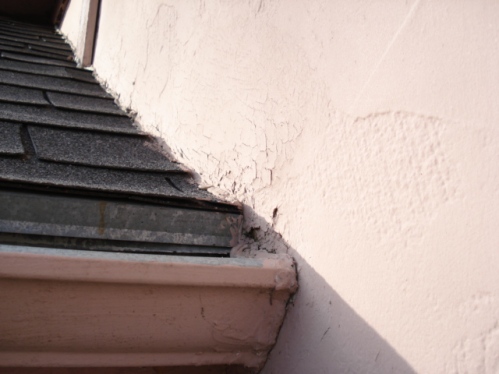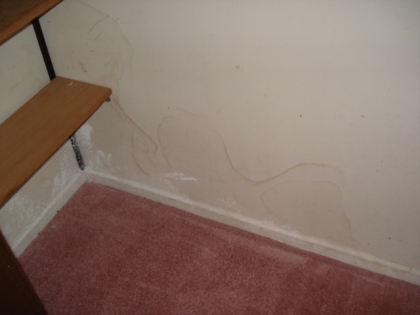 Here’s a leap year quiz for Kansas City Home Inspections. What do you see in this picture?
Here’s a leap year quiz for Kansas City Home Inspections. What do you see in this picture?
Just to help you understand what you’re looking at: This is a picture of a roofing section just above a front door of a split level home. The roof intersects with the wall of the upper level of the home.
Notice that the shingles are “wavy”? They don’t lay nice and flat. This indicates that there are multiple layers of roofing materials. If you look closely, just above the gutter, you’ll see two drip caps. This also provides suspicions of multiple roofing layers. Layered roofs won’t last as long as the manufacturer may have indicated. They can’t lay flat on roof decking, and will wear out much sooner than expected because of this.
The siding material is composite wood. Notice how it’s in contact with the shingles? Proper installation of this siding requires that this siding have a 1-2″ clearance from the roofing material. The gap should be protected by metal step flashing, and, hopefully, the siding would be painted on the bottom edge. In this installation, there has been caulking applied to the roof/wall intersection. This is a temporary attempt to keep water from damaging the siding. Too late – the siding is already deteriorating – Notice the cracking in the paint and holes in the siding? Rot has already started in the siding and wood trim (further up the roof).
 Also notice the lack of a “kick-out” flashing. The kick-out would be an extention of the step flashing (not visible) that would extend through the siding and divert water into the gutter. Without this, any water running down that caulking will seep behind the siding and into the house structure. The second picture is of the interior on the other side of this wall. Notice the moisture stains on the wall? This type of moisture damage will often lead to mold in the wall and insulation, and rot in the interior structure. Damage can also extend into lower levels as well. (Click here to see an example kick-out)
Also notice the lack of a “kick-out” flashing. The kick-out would be an extention of the step flashing (not visible) that would extend through the siding and divert water into the gutter. Without this, any water running down that caulking will seep behind the siding and into the house structure. The second picture is of the interior on the other side of this wall. Notice the moisture stains on the wall? This type of moisture damage will often lead to mold in the wall and insulation, and rot in the interior structure. Damage can also extend into lower levels as well. (Click here to see an example kick-out)
Anyone notice anything else?
The situation that has been discussed here is very common in the Kansas City area and home inspectors should always point this out. Proper repairs are required by a professional roofer to get the flashing corrected. In this case, a siding contractor would be required to make repairs to the siding, and general contractor may be needed to fix interior wall damage.
 The Exterior Design Institute (EDI), based in Norfolk, Virginia, is “a non-profit organization founded for the purpose of training and certifying Building Envelop and EIFS Inspectors and Moisture Analysts to promote quality control within the EIFS industry.”
The Exterior Design Institute (EDI), based in Norfolk, Virginia, is “a non-profit organization founded for the purpose of training and certifying Building Envelop and EIFS Inspectors and Moisture Analysts to promote quality control within the EIFS industry.”
 Here’s a leap year quiz for Kansas City Home Inspections. What do you see in this picture?
Here’s a leap year quiz for Kansas City Home Inspections. What do you see in this picture? Also notice the lack of a “kick-out” flashing. The kick-out would be an extention of the step flashing (not visible) that would extend through the siding and divert water into the gutter. Without this, any water running down that caulking will seep behind the siding and into the house structure. The second picture is of the interior on the other side of this wall. Notice the moisture stains on the wall? This type of moisture damage will often lead to mold in the wall and insulation, and rot in the interior structure. Damage can also extend into lower levels as well. (Click
Also notice the lack of a “kick-out” flashing. The kick-out would be an extention of the step flashing (not visible) that would extend through the siding and divert water into the gutter. Without this, any water running down that caulking will seep behind the siding and into the house structure. The second picture is of the interior on the other side of this wall. Notice the moisture stains on the wall? This type of moisture damage will often lead to mold in the wall and insulation, and rot in the interior structure. Damage can also extend into lower levels as well. (Click 


